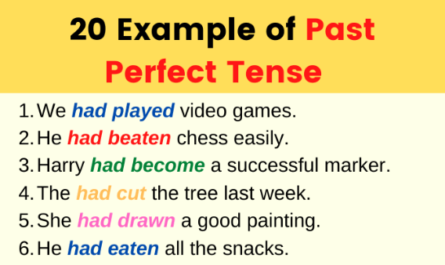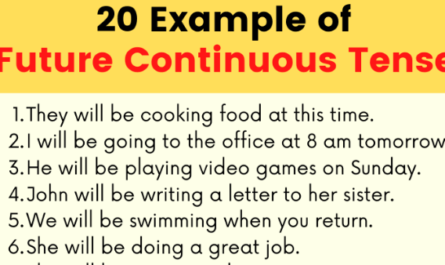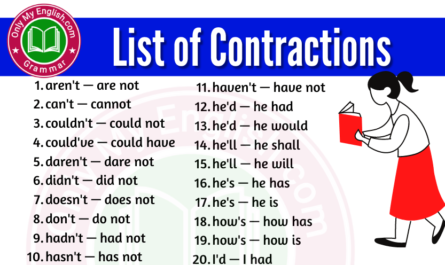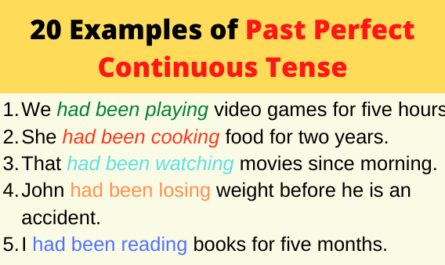In the English language, the tense is essential in English Grammar to speak appropriately.
A tense verb form describes any action, circumstance, event, or state of being in any sentence structure.
According to the time structure, Tenses are classified into three types,
What are the 3 tenses?
Apart from it, each of these three tenses is again sub-categorized into twelve types,
What are the 12 types of tenses?
- Present Simple Tense
- Present Continuous Tense
- Present Perfect Tense
- Present Perfect Continuous Tense
- Past Simple Tense
- Past Continuous Tense
- Past Perfect Tense
- Past Perfect Continuous Tense
- Future Simple Tense
- Future Continuous Tense
- Future Perfect Tense
- Future Perfect Continuous tense

Tenses in English Grammar with Examples
Let us study all the twelve types of tenses in detail,
#1. Present Tenses:
A present tense describes any action that is commonly performed or is happening in a current situation.
1.1: Present Simple Tense
Simple present tense speaks about the present actions, events, or conditions which are occurring in the current situation.
Structural formula:
Subject + verb (s/es) + object.
Here, the verb is in its base form.
Examples,
- He plays the piano.
- Romie loves to eat burgers.
- We produce biogas from manure.
- I go to the gym daily.
More: Examples of Simple Present Tense
1.2: Present Continuous (progressive) Tense
Present continuous tense is used to tell about the ongoing actions, events, or conditions and still not finished.
Structural formula:
Subject + helping verb (is / am/ are) + main verb (ing) + object.
Here, verb (ing) is the present participle form of the verb, and helping verbs (is/am/are) are used by a class of person as the first-person (am), second-person (is), and third-person (are) respectively.
Examples,
- I am dancing on the stage.
- She is looking at him.
- They are practicing on the ground.
- You are not coming with us to the picnic.
More: Examples of Present Continuous Tense
1.3: Present Perfect Tense
The present perfect tense is used to express the situation or event which is completed but in a present consequence. It is a combination of the ideal aspect done in the present tense.
Structural formula:
Subject + helping verb (have/has) + verb (ed) + object.
Here, the modal verb “has” is being used for the second person (He, She, It, etc.), and “have” is used for the first-person and third-person (I, you, they, we, etc.) respectively.
Verb(ed) is in the past participle form of the verb that shows the task’s completion.
Examples,
- He has completed the task.
- She has gone for lunch with her friends.
- I have submitted the thesis report in the HOD’s office.
- They have given three mock tests already.
More: Examples of Present Perfect Tense
1.4: Present perfect Continuous Tense
The Present perfect continuous tense shows the situation which has been started in the past and continues in the present.
Structural formula:
Subject + helping verb (have/has) + been + verb (ing) + object (optional) + since / for + time duration + object.
Here, “been” is added with the modal verbs (have/has), and verb (ing) is in the present participle form of the verb. After time duration is added with since/for (optional)
Examples,
- He has been preparing for the MPSC examination.
- You have been watching television for 2 hours.
- I have been working on this project for the last two years.
- They have not been participating in cultural event for the previous five years.
More: Examples of Present Perfect Continuous Tense
#2. Past Tenses:
Past tense is used to show the actions, events, or moments that have already happened or occurred in the past
2.1: Past Simple Tense
The simple past tense is used to describe any event, actions, moments which occurred in the past. The simple present tense is also called a preterite.
Structural formula:
Subject + verb (2nd form) + object.
Here, the verb V (2nd form) is in the past simple form.
Examples,
- I went to school in the morning.
- He wrote a letter to his father.
- They came to see my grandmother in the hospital.
- She spent her most of the time here for refreshment.
- Joseph came from London yesterday.
More: Examples of Simple Past Tense
2.2: Past Continuous (progressive) Tense
The past continuous tense is used to express the occurring circumstance or any continuing action that has happened in the past.
It is used to describe any action which is happening in the past.
Structural formula:
Subject + helping verb (was/were) + verb (ing) + object.
Here, the helping verbs (was/were) are in the past form where “was” is used for the first person and second person and “were” is used for the third person. Verb V+ing is in the present participle form to show the continuation of the action.
Examples,
- I was traveling to Los Angeles to attend a business meeting.
- They were playing an act in the annual gathering.
- He was not listening to my words.
- You were cleaning the hall yesterday after the party.
More: Examples of Past Continuous Tense
2.3: Past Perfect Tense
The past perfect tense is used to tell the happened situation which occurred before a completed action in the past. It also shows the specific time when the action occurred.
The past perfect tense is also called a pluperfect in English and combines the past tense and a perfect aspect.
Structural formula:
Subject + had + Verb (ed) + object.
Here, the modal verb “had” is used with the main verb, and the verb V (3rd form) is in the past participle form that shows the completion of the task.
Examples,
- I had never imagined that you did that night.
- She had gone to hang out with her boyfriend.
- They had rescued the entire refugees from the flooded area.
- The train had left the station by the time I reached there.
More: Examples of Past Perfect Tense
2.4: Past Perfect Continuous (progressive) Tense
The past perfect continuous tense represents any action or event that started in the past and sometimes continued until another action or another time.
It is the same as that of the past perfect tense, along with it highlights a time duration of the action that happened before something in the past.
Structural formula:
Subject + had been + Verb (ing) + object (optional) + time of action.
Here, the modal verb had is used with been, and the verb V+ing, the present participle is used to indicate the continuous for a time duration until the action finished.
Examples,
- She had been waiting for her father for more than three hours and then left together when he appeared.
- You had not only been sitting there for so long.
- They had been dancing continuously for two hours at his wedding party.
- It had been raining fastly for the whole night, so he couldn’t go home.
More: Examples of Past Perfect Continuous Tense
#3. Future tenses:
The future tense is used to express future activity or a state of being which has not happened yet and is expected to happen in the future.
3.1: Future Simple Tense
The simple future tense is used to predict or to forecast something that will happen in the future.
It is an imagination of the mind of our mind that we plan to do something.
Structural formula,
Subject + shall/will+ verb (s/es) + object.
Here, the modal verbs shall/will are used to indicate prediction and the verb V (s/es) in a simple form.
Examples,
- I shall/will go to school today.
- She will play the guitar at a cultural festival.
- They will finish their work by tomorrow morning.
- You shall not break this window glass by your hands.
More: Examples of Simple Future Tense
3.2 Future Continuous Tense
The future continuous tense is used to explain the ongoing action at a particular instant in the future or happen in the future.
Structural formula:
Subject + shall/will be + Verb (ing) + object.
Here, “be” is added with the modal verbs shall/will in a sentence, and a verb V+ing is in the present participle form to indicate the continuous action in the future.
Examples,
- Randy Orton will be fighting tonight with Roman Reigns.
- He will be writing the answers to all the questions in an examination.
- She will be singing at tonight’s concert.
- Malinga will be playing as a captain in this ICC cricket tournament.
More: Examples of Future Continuous Tense
3.3: Future Perfect Tense
The future perfect tense is used to describe a future action that has a fixed date schedule.
This is a verb form that expresses an event planned to happen at a particular instant of time in the future.
Structural formula:
Subject + shall/will + have + verb (3rd form) + object.
Here, the helping verb “have” comes along with modal verbs shall/will and is connected with the main verb V(3rd form) in the past participle form shows the completion of the task.
Examples,
- I shall have played cricket in college.
- She will have baked a cake for tomorrow’s event.
- They will have arrived in New York for their concert.
- I will have stopped looking at her when she comes near me.
More: Examples of Future Perfect Tense
3.4: Future Perfect Continuous Tense
The future perfect continuous tense is used to explain certain activities and events that are continuing or happening and done after some expected time instant.
Structural formula:
Subject + shall/will + have been + verb (ing) + object (optional) + time instant.
Here, the helping verb “have been” is used along with the modal verbs shall/will, and the main verb is in the present participle form V+ing.
Examples,
- You shall have been coming to our wedding ceremony.
- I will have been waiting for this moment for so long.
- They will have been watching movies on the laptop before he comes.
- Where will you have been waiting for me before I reach?
More: Examples of Future Perfect Continuous Tense



